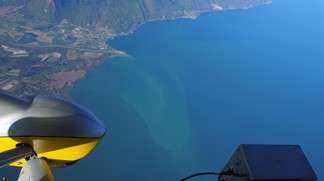Monitoring phytoplankton growth in lakes from orbit

New research shows how satellite images can be used to improve water quality monitoring campaigns in lakes and provide new insights into local, transient biological processes such as algal blooms.
With lakes and rivers under increasing pressure from human activities, campaigns to monitor their general health have been set up around the globe. In Europe, surface waters are analyzed periodically, but because collecting water samples is expensive and time consuming, lakes are often sampled at a single site only and once or twice per month at best, potentially missing a number of important biological processes. Publishing in the journal Science of the Total Environment, an international team of researchers used a decade's worth of satellite images of Lake Geneva to demonstrate how satellite images can complement and optimize monitoring field campaigns on the ground.
Human burden
In pristine lakes, low concentrations of nutrients, limit the growth of aquatic plants. But when nutrient from agricultural runoff find their way into the lake, they can lead to excessive plant growth, algal blooms. Ultimately, rotting plant mass can use up all of the oxygen in parts of the lake, to the detriment of certain fish populations. This is why nutrient levels in lakes are monitored by regularly measuring the abundance of phytoplankton. Traditionally, this is done by measuring chlorophyll concentrations in water samples drawn from the lake. But now, researchers have demonstrated how satellites can be used to acquire much more detailed information on chlorophyll concentrations in the lake's upper layers.
Using ten-year's worth of satellite images Isabel Kiefer from EPFL's Physics of Aquatic Systems Laboratory measured phytoplankton abundance in Lake Geneva. Analyzing the images taken from 2002 to 2012 by the Envisat satellite from almost 800 km altitude, they were able to observe geographic and seasonal variability in the abundance of phytoplankton at the lake surface as well as localized, short-term fluctuations that traditional methods are unable to capture. In the spring and summer, for instance, the Rhone inflow was observed to have both the highest chlorophyll concentrations and the highest variability. In the autumn, however, nutrients from the Rhone accumulate at greater depth, resulting in phytoplankton growth beyond the purview of satellites.
In addition, the data provided a means to evaluate the representativeness of the sampling sites that are currently used to monitor Lake Geneva. While the range of chlorophyll concentrations in the lake are well represented during the summer months, parts of the lake are underrepresented during the spring and autumn, warranting sampling from additional locations.
Clear or dark green?
As Damien Bouffard, the lead author of the study, explains, using satellites to accurately monitor phytoplankton growth in lakes is tricky. "Essentially, it is about translating the color of the lake water seen from space into a concentration of chlorophyll," he explains. But because factors such as the reflection of the surrounding mountains affect water color, and the transparency of the water determines how deep the satellites can "see," his team had to use complex computer algorithms to make this link. "Satellite images alone provide data with high spatial and temporal resolution, but to be accurate, they have to be continuously calibrated using manual measurements. In the long run, we want to go one step further and develop computer models that simulate the biological processes between individual satellite images," he says.
Bouffard is currently involved in an effort to develop a new fleet of miniature satellites that could take remote sensing of lake water to a whole new level. "We are currently carrying out a feasibility study with eSpace, EPFL's space engineering center, and other partners on a plan of sending six new satellites into orbit to monitor lakes and other environments. These small satellites would be equipped with cameras that are capable of detecting light across up to 100 frequency bands and would fly over Lake Geneva several times per day. If the project comes to pass, this push towards high spatial, temporal, and spectral resolution data would provide a lot of new insight into the complex dynamics of Lake Geneva and other lakes around the world," says Bouffard.
More information: "Application of remote sensing for the optimization of in-situ sampling for monitoring of phytoplankton abundance in a large lake," Science of The Total Environment, Volumes 527–528, 15 September 2015, Pages 493-506, ISSN 0048-9697, DOI: 10.1016/j.scitotenv.2015.05.011
Journal information: Science of the Total Environment
Provided by Ecole Polytechnique Federale de Lausanne




















